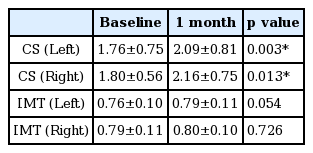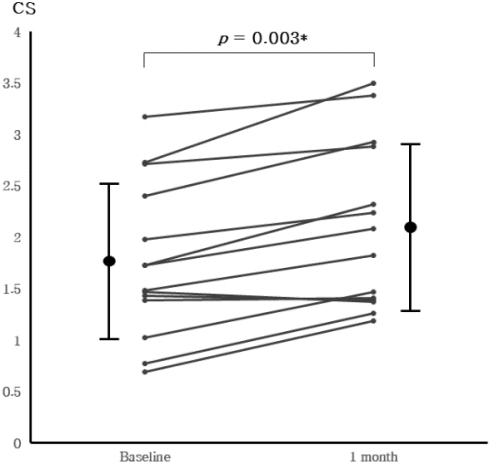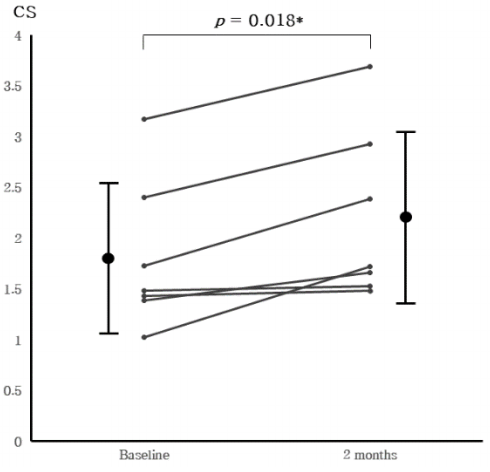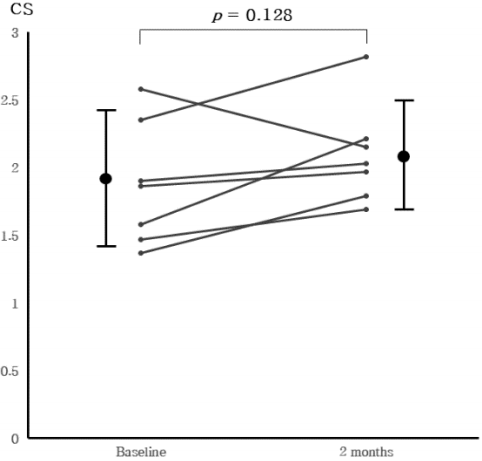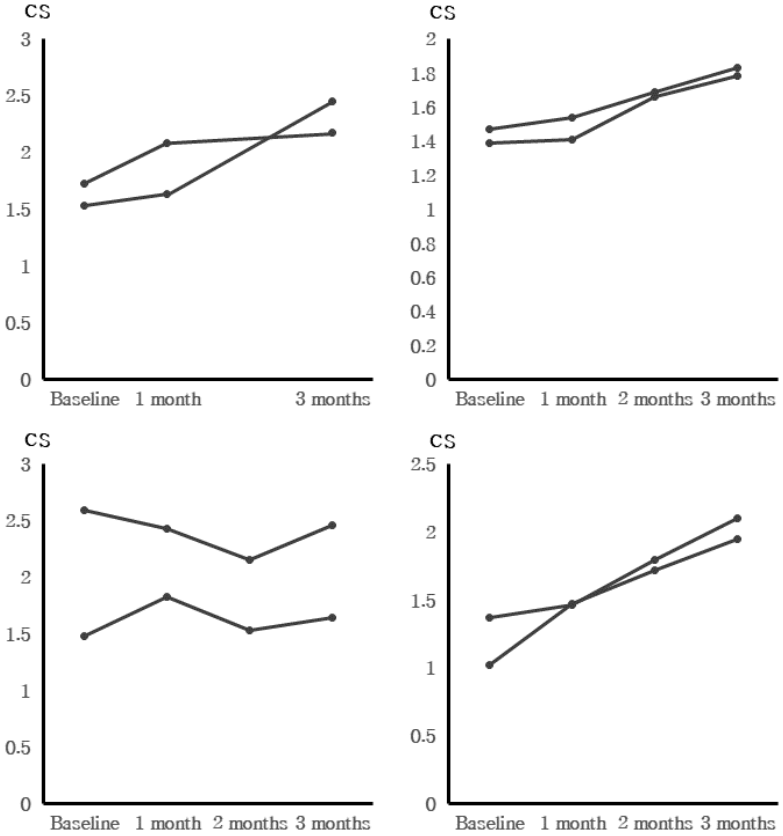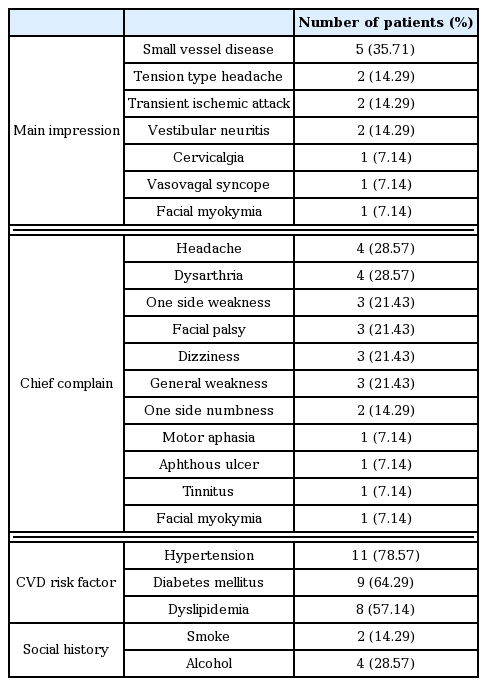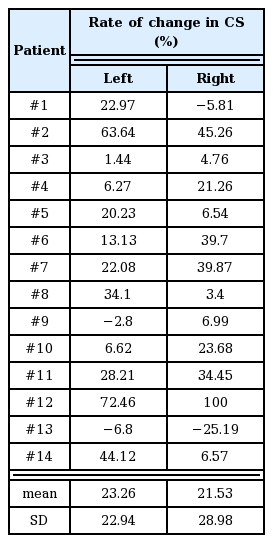References
1. Cohn JN, Duprez DA, Grandits GA. Arterial elasticity as part of a comprehensive assessment of cardiovascular risk and drug treatment. Hypertension 2005;46(1):217–220.
2. Boutouyrie P, Tropeano AI, Asmar R, Gautier I, Benetos A, Lacolley P. Aortic stiffness is an independent predictor of primary coronary events in hypertensive patients: a longitudinal study. Hypertension 2002;39(1):10–15.
3. Laurent S, Boutouyrie P, Asmar R, Gautier I, Laloux B, Guize L, et al. Aortic stiffness is an independent predictor of all-cause and cardiovascular mortality in hypertensive patients. Hypertension 2001;37(5):1236–1241.
4. Bjällmark A, Lind B, Peolsson M, Shahgaldi K, Brodin LA, Nowak J. Ultrasonographic strain imaging is superior to conventional non-invasive measures of vascular stiffness in the detection of age-dependent differences in the mechanical properties of the common carotid artery. Eur J Echocardiogr 2010;11:630–636.
5. Saji N, Toba K, Sakurai T. Cerebral small vessel disease and arterial stiffness: tsunami effect in the brain. Pulse 2016;3(3–4):182–189.
6. Jung WS, Kwon S, Cho SY, Park SU, Moon SK, Park JM, et al. The Effects of Chunghyul-Dan (A Korean Medicine Herbal Complex) on Cardiovascular and Cerebrovascular Diseases: A Narrative Review. Evid Based Complement Alternat Med 2016;2016:2601740.
7. Park HE, Cho GY, Kim HK, Kim YJ, Sohn DW. Validation of circumferential carotid artery strain as a screening tool for subclinical atherosclerosis. J Atheroscler Thromb 2012;19(4):349–56.
8. Catalano M, Lamberti-Castronuovo A, Catalano A, Filocamo D, Zimbalatti C. Two-dimensional speckle-tracking strain imaging in the assessment of mechanical properties of carotid arteries: feasibility and comparison with conventional markers of subclinical atherosclerosis. Eur J Echocardiogr 2011;Jul. 12(7):528–535.
9. Yuda S, Kaneko R, Muranaka A, Hashimoto A, Tsuchihashi K, Miura T, et al. Quantitative measurement of circumferential carotid arterial strain by two-dimensional speckle tracking imaging in healthy subjects. Echocardiography 2011;Sep. 28(8):899–906.
10. Yang EY, Dokainish H, Virani SS, Misra A, Pritchett AM, Lakkis N, et al. Segmental analysis of carotid arterial strain using speckle -tracking. J Am Soc Echocardiogr 2011;Nov. 24(11):1276–1284.
11. Saito M, Okayama H, Inoue K, Yoshii T, Hiasa G, Sumimoto T, et al. Carotid arterial circumferential strain by two-dimensional speckle tracking: a novel parameter of arterial elasticity. Hypertens Res 2012;Sep. 35(9):897–902.
12. Wierzbowska-Drabik K, Cygulska K, Cieślik-Guerra U, Uznańska-Loch B, Rechciński T, Trzos E, et al. Circumferential strain of carotid arteries does not differ between patients with advanced coronary artery disease and group without coronary stenoses. Adv Med Sci 2016;Sep. 61(2):203–206.
13. Boutouyrie P. Determinants of pulse wave velocity in healthy people and in the presence of cardiovascular risk factors: ‘establishing normal and reference values’ The Reference Values for Arterial Stiffness’ Collaboration. European Heart Journal 2010;31:2338–2350.
14. Park TH. Neuroprotective effect of Geopungchunghyul-dan on in vitro oxygen-glucose deprivation and in vivo permanent middle cerebral artery occlusion model[Dissertation] Seoul: Kyunghee Univ; 2015.
15. Park SU, Jung WS, Moon SK, Ko CN, Cho KH, Kim YS, et al. Chunghyul-dan(Qingxie-dan) improves arterial stiffness in patients with increased baPWV. Am J Chin Med 2006;34(4):553–563.
16. Min KD. The Effects of Cardiotonic Pills® on Common Carotid Artery Elasticity in Healthy Subjects [Dissertation] Seoul: Kyunghee Univ; 2016.
17. Park SU. Effect of Chunghyul-dan on Arterial stiffness: Clinical and Molecular Study [Dissertation] Seoul: Kyunghee Univ; 2005.
